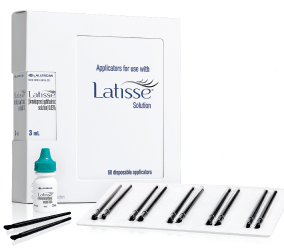 In 2002, the makeup and cosmetics industry in the
In 2002, the makeup and cosmetics industry in the
Several years ago, glaucoma patients who took Lumigan (bimatoprost 0.03%, Allergan) experienced enhanced eyelash growth.2,3 This side effect proved to be very desirable for many patients.
Seeing a potential cosmetic demand for enhanced eyelash growth, company researchers formulated Latisse (bimatoprost 0.03%, Allergan) identically to Lumigan and included specifically designed applicator wands. This month's column will discuss the science behind eyelash growth as well as the existing clinical data on Latisse and its potential side effects.
Enhanced Eyelash Growth
The eyelash life cycle includes an anagen phase, a telogen phase and a catagen phase. Eyelashes grow during the anagen phase, rest in place during the telegen phase, and experience apoptosis and shed during the catagen phase.4 So, to foster enhanced eyelash growth, we must elongate the anagen phase of the
The entire eyelash life cycle is completed in approximately four months.5 The telogen phase is the longest phase in the cycle and the catagen phase is the shortest, lasting just 15 days.4 Most individuals have 100 to 150 eyelashes per eyelid, with an average length of 6mm per lash.4 Interestingly, each lash may be in a different stage of the life cycle at any given time. The particular timing of each phase may explain why some patients require a full eight to 12 weeks to notice significant eyelash growth after starting Latisse therapy.
Results of phase III research on Latisse showed an average i ncrease of 1.4mm in length, or an increase of 26% from baseline eyelash length.6 The data also showed an improvement in both eyelash thickness and darkness. Previous research has demonstrated that melanogenesis (color/pigment accumulation) occurs during the anagen phase of the eyelash life cycle.7
ncrease of 1.4mm in length, or an increase of 26% from baseline eyelash length.6 The data also showed an improvement in both eyelash thickness and darkness. Previous research has demonstrated that melanogenesis (color/pigment accumulation) occurs during the anagen phase of the eyelash life cycle.7
It is important to note that this research revealed no increase in the number of melanocytes, but instead demonstrated an unexplained improvement in how melanin was utilized by the lash follicles. Also, the data suggested that it takes approximately one to two months for eyelash darkening to occur once a patient begins using Latisse.6
The FDA Trial of Latisse
The U.S. Food & Drug Administrations (FDA) trial of Latisse was a parallel study that examined the effects of bimatoprost and a placebo during a four-month period in a population of 278 adult patients. The researchers noted statistical improvement in eyelash growth at eight weeks, 12 weeks and 16 weeks. The research showed that 15% of the subjects experienced an improvement of at least one grade on a four-grade Global Eyelash Assessment scale at eight weeks. At 12 weeks, 69% of the subjects experienced at least one grade improvement, and at 16 weeks, 78% experienced one grade improvement.6
At the conclusion of the study, average eyelash length improved by 25% in the bimatoprost group compared to 2% in the placebo group. Additionally, eyelash thickness improved by 106% vs. 12% in the placebo group. Finally, 18% of subjects in the bimatoprost group experienced darker eyelashes, compared to 3% in the placebo group.6
Side Effects of Bimatoprost
The side effects of Lumigan include hyperpigmentation around the eyelid area, conjunctival hyperemia and the potential for iris color changes.8 Conjunctival hyperemia is the most common side effect of Lumigan, and iris pigmentation has been documented in about 1.5% of users.9,10
In the FDA trial, Latisse demonstrated approximately a 3% to 4% incidence of eyelid hyperpigmentation and conjunctival hyperemia, which resolved upon discontinuation.6 No cases of iris color changes were reported in the FDA trial.6 This is likely because Latisse is not meant to be applied to any area other than the upper eyelid margin.
Because of the potential for hyperpigmentation, conjunctival hyperemia and iris color change, make certain to inform your patients that applying more than the recommended daily dose of Latisse will neither increase nor expedite the drugs effects. Also, be sure that your patients never administer Latisse directly into their eyes. Instead, instruct them to use the applicator wand properly to apply the drop to the upper eyelid margin q.d. h.s. Finally, tell your patients to blot any excess solution that accumulates beyond the eyelid margin.
If your patients experience periorbital darkening, suggest that they discontinue Latisse; the hyperpigmentation will subside within a few days to a week.10 It is worth noting that Hispanic and African American patients may experience a higher incidence of hyperpigmentation of the periorbital skin than Caucasian patients.11
Additional Considerations
Latisse may be very beneficial for patients who have experienced hair and eyelash loss following chemotherapy. However, because of the potential for any medication to interact negatively with chemotherapeutics, the use of Latisse should be considered only after chemotherapy treatment is complete.
Additionally, Latisse is listed as a category C drug for use-in-pregnancy by the FDA.12 So, female patients who are either pregnant or nursing should not use Latisse.
We are better positioned than dermatologists or cosmetic surgeons to consult patients who are interested in the use of Latisse, because we can actively monitor for potential
complications. Furthermore, we have seven years of clinical experience in prescribing Lumigan and are familiar with its potential side effects.
Be aware, however, that certain states do not permit O.D.s to prescribe Lattise, even if those same states allow them to prescribe other glaucoma medications. (See Can You Prescribe Latisse, April 2009.) Contact your state board of optometry to verify its particular guidelines.
Nevertheless, despite the cosmetic nature of Latisse, it is our responsibility to educate patients about its proper use and application.
Dr. Karpecki is a consultant for Allergan. Dr. Shechtman has no industry affiliations to disclose. Neither Dr. Karpecki nor Dr. Shechtman have financial interests in any of the products mentioned.
1. Market Studies Inc, Oct 2002.
2. Strober BE, Potash S, Grossman ME. Eyelash hypertrichosis in a patient treated with topical latanoprost. Cutis 2001 Feb;67 (3):109-10.
3. Tosti A, Pazzaglia M, Voudouris S, et al. Hypertrichosis of the eyelashes caused by bimatoprost. J Am Acad Dermatology 2004 Nov;51(5suppl):S149-50.
4. Johnstone MA, Albert DM. Prostaglandin-induced hair growth. Surv Ophthalmol 2002 Aug;47 Suppl 1:S185-202.
5. Sasaki S. Influence of prostaglandin F2alpha and its analogues on hair regrowth and follicular melanogenesis in a murine model. Exp Dermatol 2005 May; 14(5):323-8.
8. Lee WW. Eyelash growth from application of bimatoprost in gel suspension to the base of the eyelashes.
7.
8.
9. Norubia F. Conjunctival hyperemia with the use of latanoprost versus other prostaglandin analogues in patients with ocular hypertension or glaucoma: a meta-analysis of randomized clinical trials. Br J Ophthalmol 2009 Mar;93(3):316-21.
10. Centofanti M, Oddone F, Chimenti S, et al. Prevention of dermatologic side effects of bimatoprost 0.03% topical therapy. Am J Ophthalmol 2006 Dec;142(6):1059-60.
11. Herndon LW, Robert DW, Wand M, et al. Increased periocular pigmentation with ocular hypotensive lipid use in African Americans. Am J Ophthalmol 2003 May;135(5):713-5.
12. Meadows M. Pregnancy and the Drug Dilemma. U











